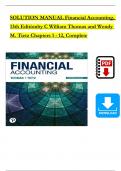SOLUTION MANUAL Financial Accounting,
13th Editionby C William Thomas and Wendy
M. Tietz Chapters 1 - 12, Complete
,
,Chapter 1
The Financial Statements
Ethics Check
(5-10 min.) EC 1-1
a. Objectivity and independence
b. Due care
c. Integrity
d. Integrity
,Short Exercises
(10 min.) S 1-1
a. Corporation, limited partners of a Limited-liability
partnership (LLP) and Limited-liability company (LLC). If
any of these businesses fails and cannot pay its liabilities,
creditors cannot force the owners to pay the business’s debts
from the owners’ personal assets. Creditors can go after the
general partner of a limited liability partnership.
b. Proprietorship. There is a single owner of the business, so the
owner is answerable to no other owner.
c. Partnership. If the partnership fails and cannot pay its
liabilities, creditors can force the partners to pay the business’s
debts from their personal assets. A partnership affords more
protection for creditors than a proprietorship because there are
two or more owners toshare this liability.
(5 min.) S 1-2
1. The entity assumption applies.
2. Application of the entity assumption will separate Osmond’s
personal assets from the assets of Simple Treats, Inc. This
will help Osmond, investors, and
, lenders know how much assets, liabilities and equity the
business has, and this knowledge will help all parties evaluate
the business realistically.
(5-10 min.) S 1-3
a. Stable-monetary-unit assumption
b. Historical cost principle; $300 is the accounting valueof the
laptop
c. Historical cost principle; the sale price is the amount
actually received from the sale
d. Entity assumption
(10 min.) S 1-4
Computed amounts in boxes
Total Assets = Total + Stockholders’
Liabilities Equity
a. $660,000 = $300,000 + $360,000
b. 85,000 = 50,000 + 35,000
c. 350,000 = 75,000 + 275,000
(5 min.) S 1-5
1. Liabilities = Assets − Owners’ Equity
,2. Owners’ Equity = Assets − Liabilities
This way of determining the amount of owners’ equityapplies to
any company or your household.
(5-10 min.) S 1-6
a. Land A g. Retained earnings S
b. Accrued expenses h. Prepaid expenses A
payable L
c. Supplies A i. Accounts payable L
d. Equipment A j. Accounts receivableA
e. Notes payable L k. Merchandise inventory
A
f. Long-term debt L l. Common stock S
(5-10 min.) S 1-7
1. Assets are the economic resources of a business thatare
expected to produce a benefit in the future.
Owners’ (stockholders’) equity represents the insiderclaims
of a business, the owners’ interest in its assets.
Assets and owners’ equity differ in that assets are
resources and owners’ equity is a claim to assets. Assets must
be at least as large as owners’ equity, soequity can be
smaller than assets.
,2. Both liabilities and owners’ (stockholders’) equity are
claims to assets.
Liabilities are the outsider claims to the assets of abusiness;
they are obligations to pay creditors.
Owners’ equity represents the insider claims to the assets of
the business; they are the owners’ interest inits assets.
(5 min.) S 1-8
1. Revenues and expenses 2. Net income (or net loss)
(10 min.) S 1-9
a. Salary expense I
b. Dividends R, C
c. Accounts payable B
d. Net income I, R, C
e. Common stock B
f. Inventory B
g. Interest revenue I
h. Cash B, C
i. Retained earnings R, B
j. Long-term debt B
k. Increase or decrease in cash C
l. Net cash provided by operating activities C
,m. Sales revenue I
n. Net cash used for financing activities C
(15-20 min.) S 1-10
a. Paying large dividends will cause retained earnings to be low.
b. Heavy investing activity and paying off debts can result in a cash
shortage even if net income has been high.
c. The single best source of cash for a business is operating
activities. This source of cash is best because it results from the
core operations of the business. Operating activities should be
the main source of cash for a business.
d. Borrowing, issuing stock, and selling land, buildings, and
equipment can bring in cash even when the company has
experienced losses. Reducing accounts receivable and inventory
can also increase cash flow.
, (5 min.) S 1-11
a. I f. I
b. B g. R
c. C h. C
d. R i. B
e. B
(5 min.) S 1-12
MacKensie Services, Inc.
Income Statement
Year Ended December 31, 2021
(millions)
Revenues ....................................... $394
Expenses........................................ 171
Net income..................................... $223
(5 min.) S 1-13
Journey Corporation
Statement of Retained Earnings
Year Ended December 31, 2021
(millions)
Retained earnings, December 31, $270
2020
Add: Net income ($460 − $380) ...... 80
, Less: Dividends declared................. (64)
Retained earnings, December 31, $286
2021
(10-15 min.) S 1-14
Jackson CorporationBalance
Sheet
December 31, 2021
(in
ASSETS millions)
Current assets:
Cash........................................................ $ 52
Accounts receivable ................................. 23
Total current assets ................................. 75
Long-term assets ......................................... 45
Total assets ................................................. $120
LIABILITIES
Current liabilities:
Accounts payable..................................... $ 21




